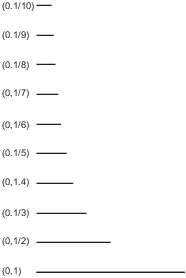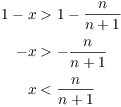The set constructions I've considered so far --- things like ![]() ,
, ![]() ,
, ![]() --- have involved finite numbers
of sets. It's often necessary to work with infinite collections of
sets, and to do this, you need a way of naming them and keeping track
of them.
--- have involved finite numbers
of sets. It's often necessary to work with infinite collections of
sets, and to do this, you need a way of naming them and keeping track
of them.
Definition. Let I be a set. A collection of sets indexed by I consists of a
collection of sets ![]() , one set
, one set ![]() for each element
for each element ![]() .
.
You could make this more precise by defining a collection of sets indexed by I to be a function from I to the class of all sets. I'll stick with this informal definition, since it won't cause us any difficulties in what we do.
Let ![]() . A collection of sets
indexed by I consists of four sets
. A collection of sets
indexed by I consists of four sets ![]() ,
, ![]() ,
, ![]() , and
, and ![]() . For example,
. For example,
![]()
Note that ![]() ; some of the
sets in the collection may be identical.
; some of the
sets in the collection may be identical.
Here's another collection of sets indexed by I:
![]()
This would not be very interesting if I were only considering finite collections of sets. Here are some infinite collections of sets.
Let ![]() . A collection of sets indexed by I is an infinite collection of sets
. A collection of sets indexed by I is an infinite collection of sets
![]() ,
, ![]() ,
, ![]() ,
, ![]() , ....
, ....
Here is a collection of sets indexed by ![]() :
:
![]()
In general, if n is a positive integer, then ![]() .
.
Here's another collection of sets indexed by ![]() :
:

In general, ![]() consists of the
integers which are divisible by n.
consists of the
integers which are divisible by n.
Now let ![]() . Here's a collection of
sets indexed by I:
. Here's a collection of
sets indexed by I:
![]()
For instance, I have sets ![]() ,
, ![]() ,
, ![]() , and so on, one for every real
number.
, and so on, one for every real
number.
Since ![]() is
uncountable, I can't list the sets in this collection
the way I could list collections of sets indexed by
is
uncountable, I can't list the sets in this collection
the way I could list collections of sets indexed by ![]() .
.
Here are a couple of the sets:
![]()
Here's another collection of sets indexed by ![]() :
:
![]()
Each set in this collection is an interval consisting of all real numbers greater than or equal to x. So, for example,
![]()
Definition. Let I be a set, and let ![]() be a collection of sets indexed by
I.
be a collection of sets indexed by
I.
(a) The union ![]() of the
of the ![]() is the set
is the set
![]()
(b) The intersection ![]() of the
of the ![]() is the set
is the set
![]()
Remark. For a collection of sets ![]() ,
, ![]() ,
, ![]() , ... indexed by the natural numbers, you
usually write the union and intersection this way:
, ... indexed by the natural numbers, you
usually write the union and intersection this way:
![]()
Example. Consider the following collection of
sets indexed by ![]() :
:
![]()
Prove:
(a) ![]() .
.
(b) ![]() .
.
The collection of intervals is shown below. They actually lie on top of one another on the x-axis; I've "pulled them up" so you can see them separately.

(a) I will show each set is contained in the other. Let ![]() . Then
. Then ![]() for some
for some
![]() . This means that
. This means that ![]() .
.
Now ![]() implies
implies ![]() , so
, so ![]() . Hence,
. Hence, ![]() .
.
This proves that ![]() .
.
Conversely, suppose ![]() . Now
. Now ![]() , so by the definition of union,
, so by the definition of union,
![]() . This
proves that
. This
proves that ![]() .
.
Hence, ![]() .
.![]()
(b) Since the empty set is a subset of any set, I have ![]() .
.
The opposite inclusion is ![]() . To show this means
to show that
. To show this means
to show that ![]() contains
no elements. I'll give a proof by contradiction.
contains
no elements. I'll give a proof by contradiction.
Suppose on the contrary that ![]() . By the definition of intersection, this
means that
. By the definition of intersection, this
means that ![]() for every positive integer n.
for every positive integer n.
Note that
![]()
In the limit definition, choose ![]() . Then there is a number M such
that for all
. Then there is a number M such
that for all ![]() , I have
, I have
![]()
Choose a positive integer n such that ![]() . Then
. Then
![]()
But this means that ![]() ,
contradicting the fact that
,
contradicting the fact that ![]() for every
positive integer n.
for every
positive integer n.
This shows that there is no such element c, so the intersection is
empty.![]()
Example. Prove that ![]() .
.
First, I'll show that the left side is contained in the right side.
Let ![]() . I have to show
that
. I have to show
that ![]() .
.
Since ![]() , I know that
, I know that ![]() for some
for some
![]() . This means that
. This means that
![]()
But

Therefore, ![]() . This means that
. This means that ![]() . Hence,
. Hence, ![]() .
.
Next, I'll show that the right side is contained in the left side.
Suppose ![]() . I have to show that
. I have to show that
![]() .
.
Since ![]() , I have
, I have ![]() . Note that
. Note that
![]()
I'll pause to give a picture of what I'll do next. The idea is that
since ![]() is
approaching 1, and since
is
approaching 1, and since ![]() , eventually the
, eventually the ![]() terms must become larger than
x:
terms must become larger than
x:

Intuitively, if all the ![]() 's stayed to the left of x,
then their limit couldn't be greater than x, so the limit couldn't be
1.
's stayed to the left of x,
then their limit couldn't be greater than x, so the limit couldn't be
1.
Continuing the proof, in the limit definition, let ![]() . Then there is a number M
such that if
. Then there is a number M
such that if ![]() ,
,
![]()
Since ![]() , the
absolute value becomes
, the
absolute value becomes
![]()
The inequality above becomes

That is, for some n I have ![]() . Since I already know
. Since I already know ![]() , I have
, I have
![]()
This means that ![]() . By the definition of union,
. By the definition of union, ![]() . Therefore,
. Therefore, ![]() .
.
Since I've proved both inclusions, I have ![]() .
.![]()
Example. Prove that
![]()
I'll show that each of the sets ![]() and
and ![]() is contained in the other.
is contained in the other.
I'll do the easy inclusion first. Let ![]() . Then
. Then ![]() .
.
For all ![]() , I have
, I have ![]() . Hence,
. Hence,
![]()
Therefore, ![]() for all
for all ![]() . By definition of intersection,
. By definition of intersection,
![]() .
.
Thus, ![]() .
.
Next, let ![]() . This
means that
. This
means that ![]() for all
for all ![]() --- that is,
--- that is,
![]()
I have to show that ![]() . Suppose on the contrary that
. Suppose on the contrary that
![]() .
.
Note that
![]()
In the limit definition, let ![]() . Then there is a number M
such that if
. Then there is a number M
such that if ![]() ,
,
![]()
(I can drop the absolute values because n is positive.)
For any n such that ![]() , I have
, I have

But this contradicts the fact that ![]() for all
for all ![]() .
.
Intuitively, since ![]() , if
, if ![]() then eventually the
then eventually the ![]() 's must shrink to
the left of x.
's must shrink to
the left of x.

If all of them stayed to the right of x, the limit would be greater than or equal to x, so it couldn't be 3.
This proves by contradiction that ![]() . Since I already know that
. Since I already know that ![]() , I have
, I have ![]() , or
, or ![]() .
.
Thus, ![]() .
.
Together with the first inclusion, this proves that ![]() .
.![]()
Copyright 2019 by Bruce Ikenaga